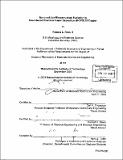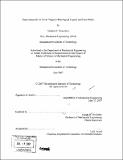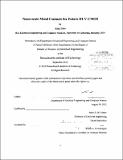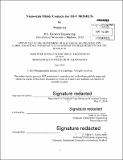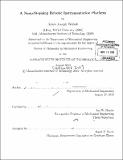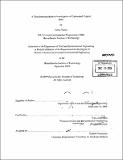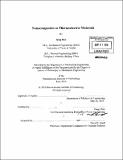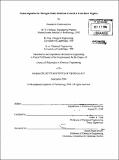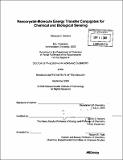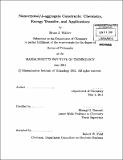Browsing MIT Theses by Title
Now showing items 38443-38462 of 61793
-
Nano-cellular microstructure evolution in ion-induced chemical vapor deposition (II-CVD) of copper
(Massachusetts Institute of Technology, 2003)A systematic investigation of the microstructure produced in ion-induced chemical vapor deposition (11-CVD) of copper from copper(I)hexafluoroacetylacetonatevinyltrimethylsilane (Cu(I)hfacVTMS) gas precursor is reported. ... -
Nano-ChemoMechanical assessment of Rice Husk Ash cement by wavelength dispersive spectroscopy and nanoindentation
(Massachusetts Institute of Technology, 2011)Cement global production stands at 3 Giga tons making concrete the most consumed structural mateial worldwide. This massively produced material comes with a heavy environmental footprint rendering the cement industry ... -
Nano-contact printing of DNA monolayers
(Massachusetts Institute of Technology, 2005)Technology today is directed towards building smaller devices. To accommodate this development, printing methods are needed. Some printing methods that are used include lithography, micro-contact printing, and inkjet ... -
Nano-engineering the boiling surface for optimal heat transfer rate and critical heat flux
(Massachusetts Institute of Technology, 2011)The effects on pool boiling characteristics such as critical heat flux and the heat transfer coefficient of different surface characteristics such as surface wettability, roughness, morphology, and porosity are not well ... -
Nano-materials for novel magneto-rheological liquids and nano-fluids
(Massachusetts Institute of Technology, 2007)Introduction: Nanotechnology, in its many forms, has evolved as a forefront of the global scientific and technological frontier. Materials once disregarded as very small dust or particulate impurities twenty years ago, are ... -
Nano-scale Glucose Fuel Cells for Energy Harvesting in the Human Body Based on Proton Conduction in Cerium Oxide
(Massachusetts Institute of Technology, 2021-06)Future implantable medical devices such as sensors, drug delivery systems, and electroceuticals require efficient, reliable, and highly miniaturized power sources. To date, the predominant power source of implants is the ... -
Nano-scale metal contacts for future III-V CMOS
(Massachusetts Institute of Technology, 2012)As modem transistors continue to scale down in size, conventional Si CMOS is reaching its physical limits and alternative technologies are needed to extend Moore's law. Among different candidates, MOSFETs with a III-V ... -
Nano-scale ohmic contacts for III-V MOSFETs
(Massachusetts Institute of Technology, 2014)As modem silicon CMOS has been scaled down to extremely small dimensions, there is an urgent need for technological innovations of new devices architectures that would allow the continuation of Moore's Law into the future. ... -
Nano-scale scratching in chemical-mechanical polishing
(Massachusetts Institute of Technology, 2008)During the chemical-mechanical polishing (CMP) process, a critical step in the manufacture of ultra-large-scale integrated (ULSI) semiconductor devices, undesirable nano-scale scratches are formed on the surfaces being ... -
A nano-stepping robotic instrumentation platform
(Massachusetts Institute of Technology, 2013)The development of an Autonomous Nano-stepping Tool (ANT) system is presented. Each ANT is a small, tripodal, robotic instrument capable of untethered precision motion within a quasi-three-dimensional workspace of arbitrary ... -
A nanobody suite for yeast scaffold nucleoporins provides details of the Y complex structure and nuclear pore complex assembly
(Massachusetts Institute of Technology, 2020)Nuclear pore complexes (NPCs) are the main conduits for molecular exchange across the nuclear envelope. The NPC is a modular assembly of ~500 individual proteins, called nucleoporins or nups, that can be classified into ... -
A nanochemomechanical investigation of carbonated cement paste
(Massachusetts Institute of Technology, 2009)Concrete, and in particular its principal component, cement paste, has an interesting relation with carbon dioxide. Concrete is a carbon dioxide generator-- it is estimated that 5-10% of atmospheric CO₂ comes from this ... -
Nanocomposite catalysts for soot combustion and propane steam reforming
(Massachusetts Institute of Technology, 2007)A nanocomposite system, CuO-Ag/CeO 2, has been successfully developed to complete carbon black combustion by 400*C. This novel catalyst has excellent potential for application in the emission control of soot particulates ... -
Nanocomposites as thermoelectric materials
(Massachusetts Institute of Technology, 2010)Thermoelectric materials have attractive applications in electric power generation and solid-state cooling. The performance of a thermoelectric device depends on the dimensionless figure of merit (ZT) of the material, ... -
Nanocomposites for nitrogen oxide emissions control in lean-burn engines
(Massachusetts Institute of Technology, 2004)(cont.) reducing agent than propane in the SCR of NO. Pt-Rh/CuO/A1₂O₃ nanocomposites capable of adsorbing SO₂ in oxygen-rich environment as metal sulfates and releasing SO₂ in reducing atmosphere were synthesized with ... -
Nanocontacts controlled atom-by-atom in an ion-crystal friction emulator
(Massachusetts Institute of Technology, 2016)Friction is the basic, ubiquitous mechanical interaction between two surfaces that results in resistance to motion and energy dissipation. To test long-standing atomistic models of friction processes at the nanoscale, we ... -
Nanocrystal-molecule energy transfer conjugates for chemical and biological sensing
(Massachusetts Institute of Technology, 2008)New tools and probes are constantly being developed for chemical and biological sensing. As novel materials emerge, growing demand for sensing in specific applications can be addressed. One such class of materials is ... -
Nanocrystal/J-aggregate constructs : chemistry, energy transfer, and applications
(Massachusetts Institute of Technology, 2011)The interaction of light with matter is one of the most central subjects to modern chemistry. Two types of materials, semiconductor nanocrystals and J-aggregates of cyanine dyes, have been developed chiefly due to their ... -
Nanocrystalline alloys : enhanced strengthening mechanisms and mechanically-driven structural evolution
(Massachusetts Institute of Technology, 2011)Nanocrystalline materials have experienced a great deal of attention in recent years, largely due to their impressive array of physical properties. In particular, nanocrystalline mechanical behavior has been of interest, ... -
Nanocrystalline perovskites for catalytic combustion and oxygen separation
(Massachusetts Institute of Technology, 2002)Nanocrystalline perovskites (Lal-xAMnl-yByO3) were successfully synthesized with higher surface area and smaller grain size by chemical co-precipitation compared to solid-state and complexation/combustion synthesis routes. ...
